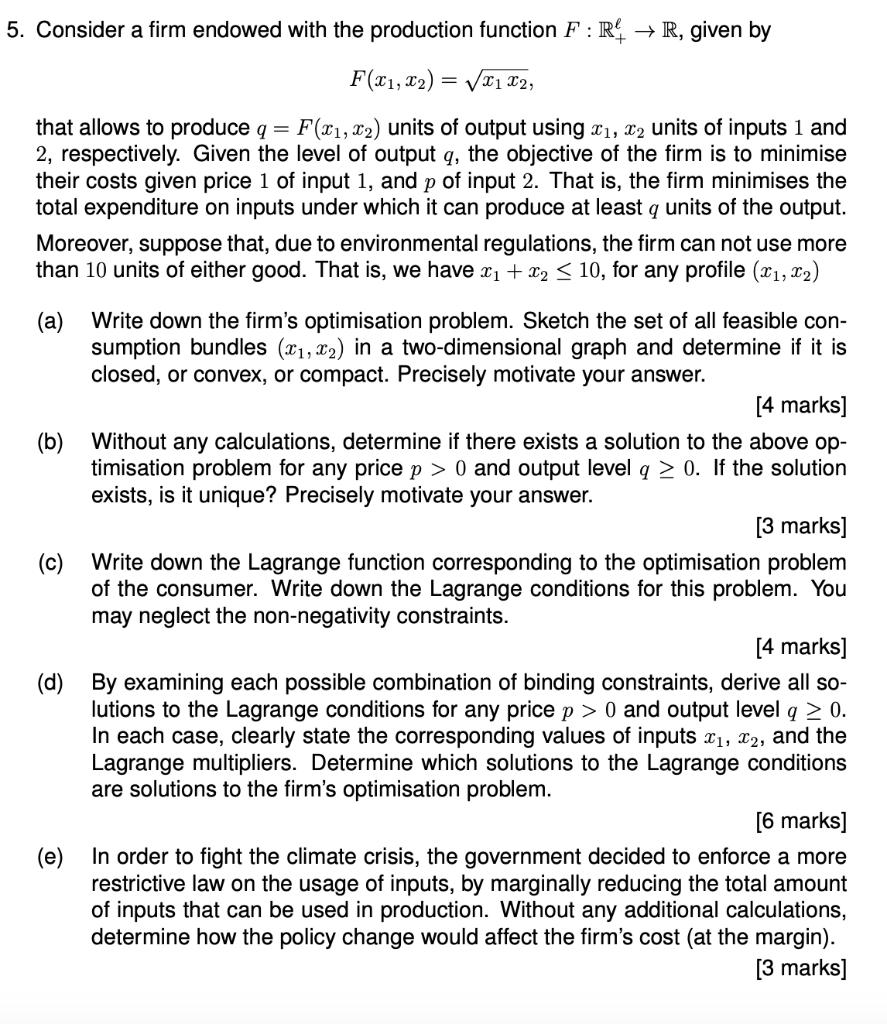Answered step by step
Verified Expert Solution
Question
1 Approved Answer
5. Consider a firm endowed with the production function F: R R, given by F(x1, x2)=x1x2, that allows to produce q = F(x1, x2)

5. Consider a firm endowed with the production function F: R R, given by F(x1, x2)=x1x2, that allows to produce q = F(x1, x2) units of output using , 2 units of inputs 1 and 2, respectively. Given the level of output q, the objective of the firm is to minimise their costs given price 1 of input 1, and p of input 2. That is, the firm minimises the total expenditure on inputs under which it can produce at least q units of the output. Moreover, suppose that, due to environmental regulations, the firm can not use more than 10 units of either good. That is, we have x + x2 10, for any profile (x1, x) (a) Write down the firm's optimisation problem. Sketch the set of all feasible con- sumption bundles (x, x2) in a two-dimensional graph and determine if it is closed, or convex, or compact. Precisely motivate your answer. (b) (c) [4 marks] Without any calculations, determine if there exists a solution to the above op- timisation problem for any price p > 0 and output level q 0. If the solution 9 exists, is it unique? Precisely motivate your answer. [3 marks] Write down the Lagrange function corresponding to the optimisation problem of the consumer. Write down the Lagrange conditions for this problem. You may neglect the non-negativity constraints. [4 marks] (d) By examining each possible combination of binding constraints, derive all so- lutions to the Lagrange conditions for any price p 0 and output level q 0. In each case, clearly state the corresponding values of inputs , 2, and the Lagrange multipliers. Determine which solutions to the Lagrange conditions are solutions to the firm's optimisation problem. [6 marks] (e) In order to fight the climate crisis, the government decided to enforce a more restrictive law on the usage of inputs, by marginally reducing the total amount of inputs that can be used in production. Without any additional calculations, determine how the policy change would affect the firm's cost (at the margin). [3 marks]
Step by Step Solution
★★★★★
3.48 Rating (158 Votes )
There are 3 Steps involved in it
Step: 1
a The firm s optimization problem is to minimize total expenditure on inputs given a level of output ...
Get Instant Access to Expert-Tailored Solutions
See step-by-step solutions with expert insights and AI powered tools for academic success
Step: 2

Step: 3

Ace Your Homework with AI
Get the answers you need in no time with our AI-driven, step-by-step assistance
Get Started


